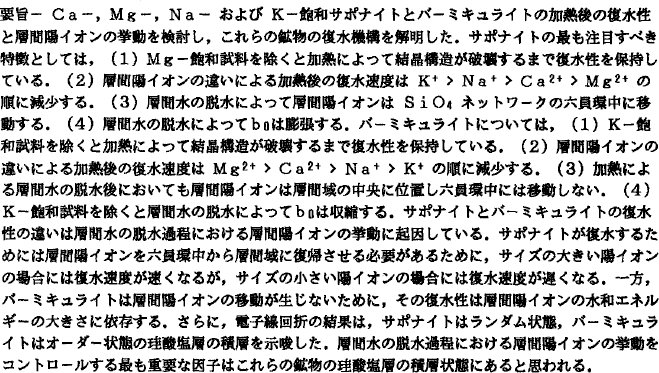Article contents
Dehydration and Rehydration of Saponite and Vermiculite
Published online by Cambridge University Press: 02 April 2024
Abstract
The rehydration properties and behavior of interlayer cations of Ca-, Mg-, Na-, and K-saturated homoionic saponite and vermiculite heated at various temperatures were examined and their rehydration mechanisms elucidated. The most notable features of saponite were (1) except for the Mg-saturated specimen, all saponite samples rehydrated until the crystal structure was destroyed by heating; (2) the rehydration rate in air after heating decreased in the order: K+ > Na+ > Ca2+ > Mg2+; (3) the interlayer cations apparently migrated into hexagonal holes of the SiO4 network on thermal dehydration; and (4) the b-parameter expanded on thermal dehydration. The rehydration properties and behavior of interlayer cations of vermiculite were: (1) except for the K-saturated specimen, all vermiculite samples rehydrated until the crystal structure was destroyed by heating; (2) the rehydration rate in air after heating decreased in the order: Mg2+ > Ca2+ > Na+ > K+; (3) the interlayer cations apparently did not migrate into the hexagonal holes, but remained at the center of the interlayer space, even after thermal dehydration; and (4) except for the K-saturated specimen, the 6-parameters of the samples contracted on thermal dehydration. The different rehydration properties of saponite and vermiculite were apparently due to the behavior of the interlayer cations during thermal dehydration. For rehydration to occur, the interlayer cations of saponite had to migrate out of the hexagonal holes. Consequently, saponite saturated with a large cation rehydrated rapidly, whereas saponite saturated with a small cation rehydrated slowly. On the other hand, the interlayer cations of vermiculite remained in the interlayer space; therefore, the rehydration properties of vermiculite were strongly affected by the hydration energies of the interlayer cations. Furthermore, electron diffraction patterns suggested that the saponite and vermiculite consisted of random stacking and ordered stacking of adjacent 2:1 layers, respectively. The nature of the stacking of the minerals seemed to be the most important factor controlling the behavior of interlayer cations in the thermal dehydration process.

Keywords
- Type
- Research Article
- Information
- Copyright
- Copyright © 1991, The Clay Minerals Society
References
- 40
- Cited by




